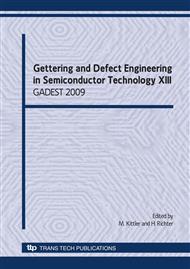p.325
p.331
p.337
p.343
p.351
p.357
p.363
p.369
p.375
Hydrogen-Induced Passivation of Grain-Boundary Defects in Polycrystalline Silicon
Abstract:
The influence of the hydrogen content in the amorphous starting material on hydrogen bonding and defect passivation in laser annealed polycrystalline silicon is investigated. The samples are characterized using electron paramagnetic resonance and hydrogen effusion measurements. After laser dehydrogenation and crystallization the samples contain a residual H concentration of up to 8×1021 cm-3. During a vacuum anneal at least 1.5×1021 cm-3 are mobile of which only 3.7×1018 cm-3 H atoms passivate preexisting Si dangling bonds. It is shown that a vacuum anneal can cause the vast majority of H atoms to accumulate in platelet-like structures. Defect passivation and platelet nucleation and growth occur spatially separated requiring long range H diffusion.
Info:
Periodical:
Pages:
351-356
Citation:
Online since:
October 2009
Authors:
Price:
Сopyright:
© 2010 Trans Tech Publications Ltd. All Rights Reserved
Share:
Citation:


